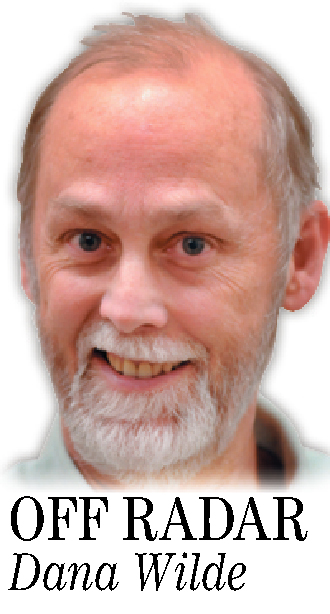Since Abby Shahn and Mark Melnicove’s book “Ghosts” essentially invites it, let me tell you a story.
One October around the time Maine was just getting to be known as Stephen King country, a bunch of us college students spent a beer-brightened weekend at a friend’s family camp near Livermore Falls. It was raucous with guitars, cigarettes and ill-informed philosophical arguments, but pretty innocent. No drug dealers, and while there may have been a joint or two circulating, we were psychically none the worse for wear.
I make this latter point because of what happened to me sometime in the larger wee hours of the second night. After the uproar subsided, we all retired to the same couches and floor-nooks we’d staked out, mostly stochastically, the first night. I was on a cot on a raised section of the spacious, finished-wood common room. Sometime in the predawn, I woke up. I remember scanning the array of shadowy furniture shapes and sleeping bodies in the moonlit room. My eyes drifted toward the high ceiling. Holy crap.
Suspended there, completely motionless, was a woman in profile. Her body was folded at the waist and knees, her head tipped slightly back, kind of like angels you see in certain Renaissance paintings. Her shawl-like clothing was a chiaroscuro of light brown and sepia colors. Her face a side-view Botticelli. Most startling was her complete, total stillness.
This can’t be real, I thought. Am I dreaming?
I’ve since realized that if you have to ask yourself if you’re dreaming, then you’re dreaming. Or some psychic variation thereof. This was one of the variations. I studied her form, memorized its position at the ceiling so I could compare nearby objects later, in daylight. If I had any sketching skills, which I don’t, I could draw her for you today.
I remember feeling, not scared, but startled, confused and fascinated. And not to put too fine a point on it, but I’ve encountered a number of these motionless figures since then, most of them during sleep events that were clearly different from your standard chaotic nighttime dream. I don’t know what you’re supposed to call this. I call it ghosts.
So it was with a reality-based willingness to suspend disbelief that I opened “Ghosts” and began looking at the rich reproductions of Abby Shahn’s paintings of ghost figures. In most of the paintings the compositions are similar — oblong, humanlike shapes in varying colors, some of them light brown, orange, sepia, foggily distant-seeming yet right there in somebody’s shed. And true to my own experience, complete stillness. This can’t be real.
And yet, somehow, it is. Side by side with each painting is a poem by Mark Melnicove, each of which, as Shahn notes of each viewer, “adds his own meaning, his own ghosts.” Melnicove’s ghosts are not carefree. Whether they are disembodied spirits, the psychic remains of the dead, or figures of deep, sort of Jungian psychic disturbances, varies like the paintings. And like the paintings, the atmosphere of their reality is self-similar but distinct. There are numerous figures of motionless figures hanging in the air, here. “Grudge-holding ghosts”; “rapacious ghosts”; “hungry ghosts”; “ceremonial ghosts, snacking on corpuscles”.
There are “guardian ghosts”, “shopworn ghosts”, and “Ghosts flying up over lilac, lovage, morning / glories, red and white clover”. There are “unconscious ghosts” strongly reminiscent of an anecdote of University of Maine researcher Kyriacos Markides about two Cypriot people who had passed on but didn’t know it and were self-confined to the same house, going about the same routines, in misery so totally the same as in their lives that death to them was indistinguishable from life.
I hadn’t realized death had undone so many. Yet neither Melnicove’s nor Shahn’s ghosts are simply the sheeted dead squeaking and gibbering in the street.
Ghosts do not mirror exactly
who you think you are
when you pose before them.
They project their own take
on your idea of yourself
And possibly dangerously, the ancestral ghosts of Melnicove’s poems elicit anger, resentment and bitterness, affection and bewilderment, possessiveness, regret. “My body attracts the ghost of my father who wants / to rob me of my spunk.”
The imagery and the language of the poems are conversational, but arranged to create a sense of uncomfortable oddness, a by and large truly wraithlike atmosphere that I, at least, recognize. Not frightening, mostly, but uneasily dreamlike. There are more things in heaven and earth than are dreamt of in our scientific philosophies, not to mention our memories of camp weekends.
Mark Melnicove lives in Dresden, and is a former director of the Maine Writers and Publishers Alliance and author of “The Uncensored Guide to Maine.” Abby Shahn lives in South Solon. Her artwork has appeared in the Portland Museum of Art, the Farnsworth Art Museum and City Lights Books in San Francisco, among many others. “Ghosts” is available by writing to Melnicove at 216 Cedar Grove Road, Dresden, or emailing mmelnicove@roadrunner.com or abigailshahn@gmail.com.
Off Radar takes note of poetry and books with Maine connections the first and third Thursdays of each month. Contact Dana Wilde at universe@dwildepress.net.
Send questions/comments to the editors.




Success. Please wait for the page to reload. If the page does not reload within 5 seconds, please refresh the page.
Enter your email and password to access comments.
Hi, to comment on stories you must . This profile is in addition to your subscription and website login.
Already have a commenting profile? .
Invalid username/password.
Please check your email to confirm and complete your registration.
Only subscribers are eligible to post comments. Please subscribe or login first for digital access. Here’s why.
Use the form below to reset your password. When you've submitted your account email, we will send an email with a reset code.